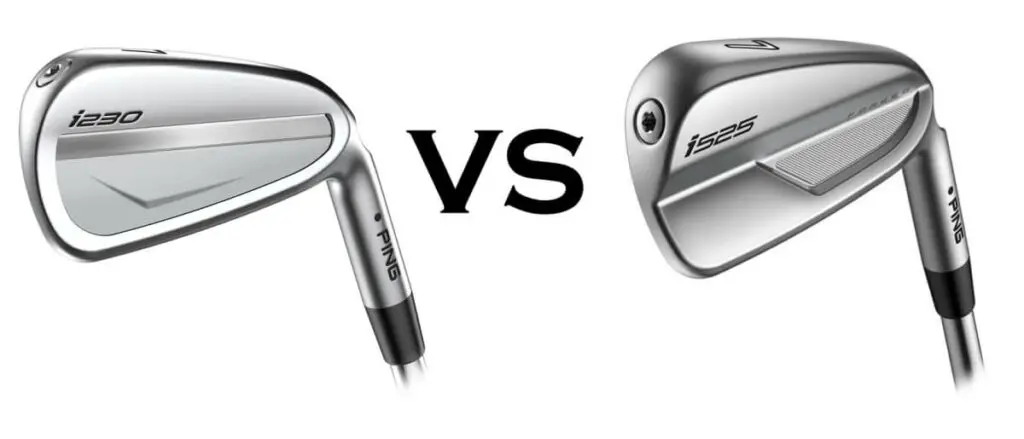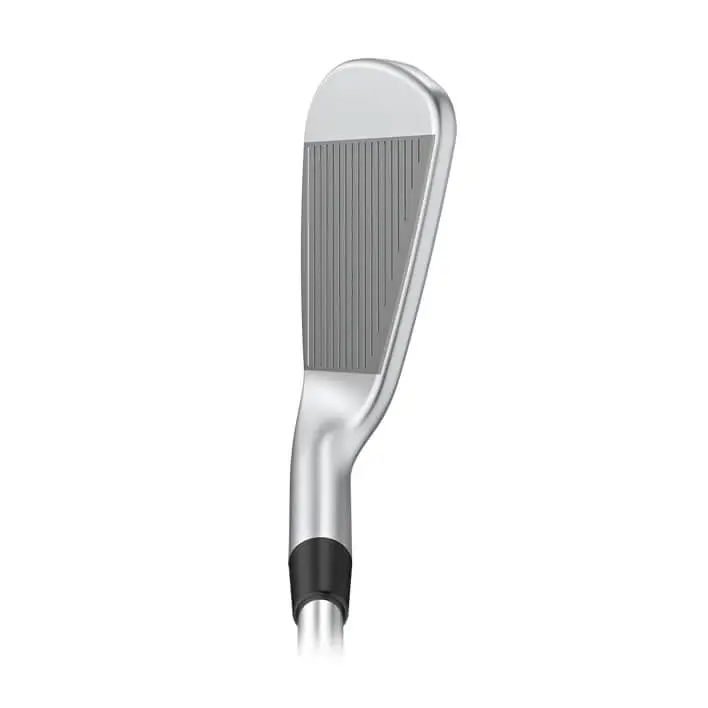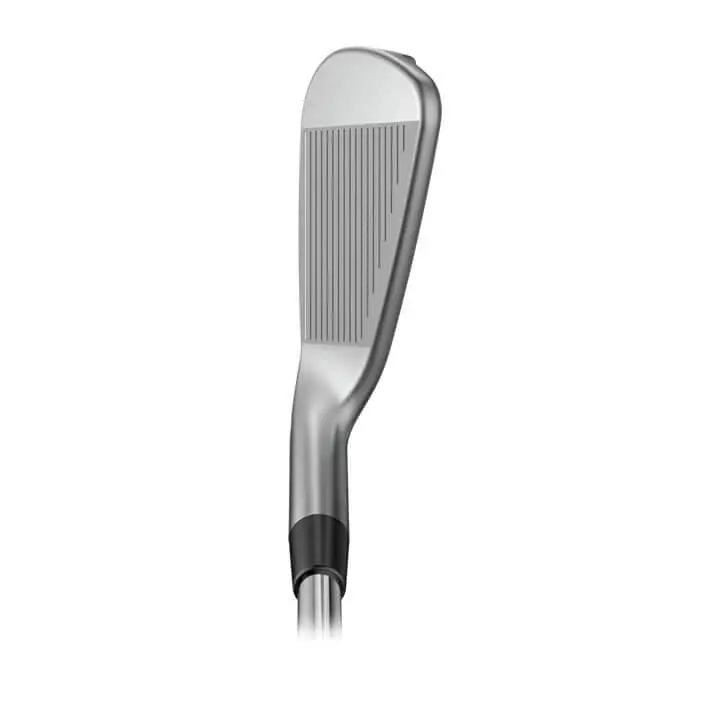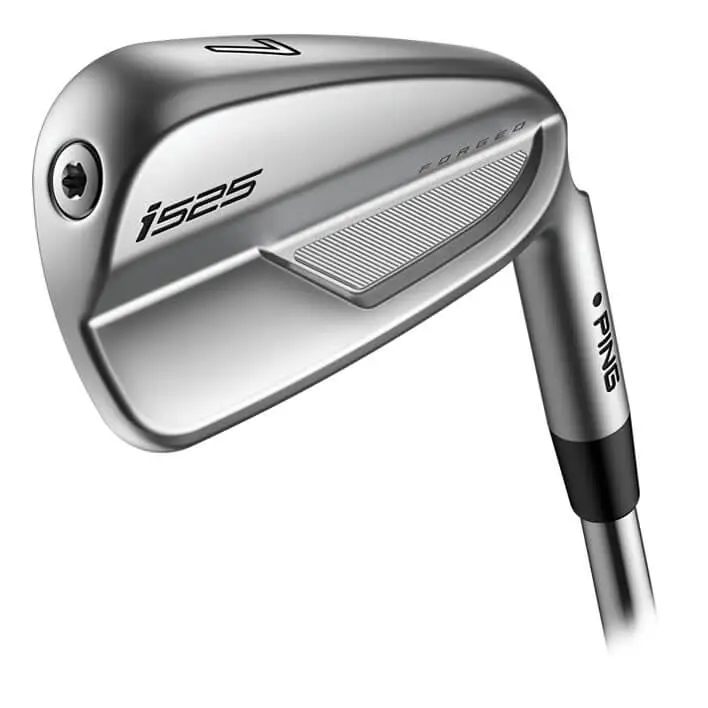The Ping i230s are the official upgrades Ping i210s. It took a full 4 years for Ping to bring them out. They are considered forgiving player irons that offer good distance, great feell and exceptional accuracy.
The Ping i525s are player distance irons that look absolutely fantastic at address. They use a hollow body iron head to deliver exceptional ball speeds, making them a great option for any low or mid-handicap golfer that needs a bit of extra distance to reach greens in regulation consistently.
Now let’s dive into the details of this comparison between the Ping i230 vs i525 irons.
Loft Comparison
Default Lofts - i230 vs i525 Irons
| CLUB | i230 | i525 |
|---|---|---|
| 3-iron | 19.0° | 18.0° |
| 4-iron | 22.5° | 21.0° |
| 5-iron | 26.0° | 24.0° |
| 6-iron | 29.5° | 27.0° |
| 7-iron | 33.0° | 30.5° |
| 8-iron | 37.0° | 35.0° |
| 9-iron | 41.0° | 40.0° |
| PW | 45.0° | 45.0° |
| UW | 50.0° | 50.0° |
In terms of the default lofts, it’s pretty clear that the i525s pack more punch than the more traditional lofts of the i230 irons. This makes sense, given that they fall into slightly different iron categories.
The difference in default lofts is most noticeable in the mid irons, where it can be as large as 2.5 degrees (6 iron and 7 iron). The loft difference is less significant from 9 iron to gap wedge, although the i525s will still travel further due to the hot face and hollow body construction.
Power Spec Lofts
| CLUB | i230 | i525 |
|---|---|---|
| 3-iron | 19.0° | 18.0° |
| 4-iron | 22.0° | 21.0° |
| 5-iron | 25.0° | 24.0° |
| 6-iron | 28.0° | 27.0° |
| 7-iron | 31.5° | 30.5° |
| 8-iron | 35.5° | 35.0° |
| 9-iron | 40.0° | 40.0° |
| PW | 44.5° | 45.0° |
| UW | 49.5° | 50.0° |
The power spec lofts of the i525 irons are exceptionally strong in the lower irons (3 to 5 iron) and the mid irons (6 iron to 8 iron). In fact, the lofts are so strong, it’s hard to imagine what type of golfer would benefit from using them. For instance, the 3 iron has a loft of 17 degrees. That’s literally one degree short of being classified as a 1 iron.
Conversely, the power spec lofts of the i230 irons are far easier to digest. If you want the pinpoint accuracy of the i230s but still need a bit more length than the default lofts can offer, the power spec lofts could be a perfect match.
Retro Spec Lofts
| CLUB | i230 | i525 |
|---|---|---|
| 3-iron | 21.0° | 20.0° |
| 4-iron | 24.5° | 23.0° |
| 5-iron | 28.0° | 26.0° |
| 6-iron | 31.5° | 29.0° |
| 7-iron | 35.0° | 32.5° |
| 8-iron | 39.0° | 37.0° |
| 9-iron | 43.0° | 42.0° |
| PW | 47.0° | 47.0° |
| UW | 52.0° | 52.0° |
Only players with extremely fast swing speeds will consider the retro spec Ping i230s. However, there is definitely a case for players with fast or extra fast swing speeds to consider the retro spec Ping i525s. They will still deliver great distance, albeit with a bit more height and backspin.
Ping i230 Power Spec Lofts vs i525 Standard Lofts
| CLUB | i230 | i525 |
|---|---|---|
| 3-iron | 19.0° | 18.0° |
| 4-iron | 22.0° | 21.0° |
| 5-iron | 25.0° | 24.0° |
| 6-iron | 28.0° | 27.0° |
| 7-iron | 31.5° | 30.5° |
| 8-iron | 35.5° | 35.0° |
| 9-iron | 40.0° | 40.0° |
| PW | 44.5° | 45.0° |
| UW | 49.5° | 50.0° |
We’ve included this table because it’s as close as these irons get from a loft perspective. There are plenty of golfers that may want the distance of the i525, but still want the accuracy and feel of the i230. As a result, the power spec versions of the i230 irons should actually be quite popular.
As you can see, the lofts of the Power Spec i230s are very similar to the lofts of the standard i525 irons. In the lower irons (3 iron to 6 iron 7 iron) the difference is 1 degree. From 8 iron to gap wedge, there is half a degree difference in some clubs (8 iron, PW, UW) and the exact same loft in others (9 iron).
Interestingly, the power spec i230 gap wedge is actually half a degree stronger than the i525 gap wedge.
Offset, Bounce & Swing Weight
| CLUB | i230 | i525 |
|---|---|---|
| 3-iron | 0.20" - 5.0° - D1 | 0.19" - 5.0° - D0 |
| 4-iron | 0.17" - 6.0° - D1 | 0.16" - 6.0° - D0 |
| 5-iron | 0.14" - 7.0° - D1 | 0.13" - 7.0° - D0 |
| 6-iron | 0.12" - 8.0° - D1 | 0.11" - 8.0° - D0 |
| 7-iron | 0.09" - 9.0° - D1 | 0.08" - 9.0° - D0 |
| 8-iron | 0.07" - 10.5° - D1 | 0.06" - 10.0° - D0 |
| 9-iron | 0.05" - 12.0° - D1.5 | 0.04" - 11.5° - D0.5 |
| PW | 0.03" - 13.0° - D2 | 0.02" - 13.0° - D2 |
| UW | 0.02" - 13.0° - D2 | 0.02" - 13.0° - D2 |
Offset: In terms of offset, the Ping i230s are actually quite similar to the Ping i525s. Technically speaking, the Ping i525s actually have less offset, but the difference is marginal.
Swing Weight: With regards to swing weight, it’s pretty clear that the Ping i525 irons are a touch lighter than the Ping i230 irons. Most of the Ping i525s are classified as ‘D0’, while most of the Ping i230s are classifed as ‘D1’. It’s not a drastic difference in swing weight, but it’s still worth noting.
Lie Angle & Length Comparison
| CLUB | i230 | i525 |
|---|---|---|
| 3-iron | 59.0° - 39" | 60.0° - 39 1/2" |
| 4-iron | 59.8° - 38 1/2" | 60.5° - 38 7/8" |
| 5-iron | 60.5° - 38" | 61.0° - 38 1/4" |
| 6-iron | 61.3° - 37 1/2" | 61.5° - 37 5/8" |
| 7-iron | 62.0° - 37" | 62.0° - 37" |
| 8-iron | 62.8° - 36 1/2" | 62.8° - 36 1/2" |
| 9-iron | 63.5° - 36" | 63.5° - 36" |
| PW | 64.1° - 35 1/2" | 64.1° - 35 1/2" |
| UW | 64.1° - 35 1/2" | 64.1° - 35 1/2" |
The lie angle specs of these irons sets are very similar. The i230 irons are slightly flatter in the lower irons (3 iron to 6 iron). From 7 iron down, the lie angle specs are exactly the same.
It’s worth noting that the lower lofted Ping i525s (3 iron to 6 iron) have slightly longer shafts than the equivalent Ping i230 irons. From 7 iron to gap wedge, the shaft lengths are exactly the same.
Key Differences
1. Handicap Range
The Ping i230s are designed for tour players, elite amateurs, and single-figure handicaps. The handicap range is basically 0 – 10, although players with high swing speeds could also consider putting them in the bag.
The Ping i525s are designed for a larger range of golfers. If you have a moderate or medium-fast swing speed, there’s a good chance the i525s could be very well suited to your game. The handicap range is basically from 3 – 15, which represents a very large portion of the golfing market.
- Ping i230: 0 – 10 Handicaps
- Ping i525 Irons: 3 – 15 Handicaps
2. Player Irons vs Player Distance Irons
The i230s are considered player irons, whereas the i525s are considered player-distance irons. The whole goal with player distance irons is to produce a high launch, low spin, and maximum ball speed combination.
Conversely, the goal with the i230s is to produce amazingly consistent ball speed numbers that allows tour players and elite amateurs to maximize distance control. If you make good contact and you’re hitting out of the fairway, the i230s should provide you with exceptionally consistent distance numbers.
That being said, the i525s continue to be very popular in the amateur game, because you can gain anywhere from 1 to 2 clubs by making the switch, depending on what irons you currently play.
3. Distance Consistency
If you analyze the i525 product page, you will notice that the irons are built with a maraging steel face and hollow body construction. Both of these attributes contribute to what can only be described as a hot face, where the ball literally shoots off the clubface. This combination works very well for maximizing the ball speed of players with medium and medium-fast swing speeds.
On the other side of the spectrum, the i230s don’t have a hollow body, and they also don’t have a maraging-steel face. Instead, Ping have employed a standard iron face, while focusing on lowering the CG in order to improve distance.
More importantly, the i230s are far less likely to produce unexpectedly long golf shots. If you make a good swing, they should provide pinpoint distance control. With the i525s, you may run into some situations where the ball travels further than intended. It is the biggest weakness of player distance irons in general.
4. Accuracy
In a head-to-head battle of accuracy, the Ping i230s will win in almost all scenarios. This is primarily because proximity to the hole is determined by both distance and direction.
Because the i230s provide better distance dispersion, you are more likely to end up closer to the hole on your approach shots, provided you make good contact with the ball.
5. Forgiveness
Technically speaking, the Ping i525s are more forgiving if you don’t make perfect contact with the ball. In most cases, they will still travel a fair distance, even when you impart a mediocre strike.
However, the Ping i230s are some of the most forgiving player irons that you can buy. Unlike so many player irons that require borderline magnificent ballstriking to be considered gameable, the Ping i230s don’t actually fall into this camp. Provided you make reasonably good contact, the i230s will deliver consistently good ball flight and distance numbers.
This is partially why the i230s are so popular. They are can be classified as a highly forgiving player iron. This increases the appeal of the i230 irons and it means that mid-handcappers should absolutely test them out before assuming that the i525s are the better fit for their game.
Product Technology
Ping i230 Irons

Premium Feel, Sound: A consistently more pleasing feel and sound in every iron result from a four-layer cavity badge that damps undesirable frequencies, working in concert with a soft elastomer insert behind the badge in the 431 stainless steel head.
Low CG, Higher MOI: Activated elastomer saves significant weight that is re-allocated to achieve a low CG for more distance and (with tungsten toe and tip weights) increases forgiveness. The elastomer reinforces the face, providing more consistent bending and energy transfer to generate a higher, stronger ball flight.
Rounded Lead Edge: The sole design is similar to the tour-proven i210 irons, with a more rounded lead edge and ample bounce to promote smooth turf interaction for clean, solid ball striking.
MicroMax Grooves: Precision-milled MicroMax grooves deliver consistent launch and spin for accuracy in the long irons and greater control in the short irons and wedges, especially in wet conditions where the grooves and hydropearl 2.0 chrome finish ensure low launch angles with high spin.
Compact Long Irons: For consistent clubface delivery and greater accuracy in the long irons, the 3-5 irons are slightly more compact than i210, while the mid and short irons are similar blade lengths, creating a tour-preferred look across the set. Pictured above are the 4-iron (left), and 7-iron.
Consistent Gapping: The i230 delivers predictable and repeatable distance with the control and playability to hit precise yardages, ensuring the gapping consistency expected of a players-style iron.
Custom-Fit Shafts: A variety of shafts are available, including the mid-launching True Temper DG 105 in steel, and the PING ALTA CB Black graphite, which delivers a mid-to-high launch with stability and a consistent feel.
Product info sourced from Ping i230 Product Page
Ping i525 Irons

Forged, Maraging Steel Face: The strength of the variable-thickness, maraging steel allows for a thinner, more dynamic face structure with an internal sole undercut in the 17-4 stainless steel body to increase flexing to launch shots faster and higher with predictability.
Extreme Weighting: Tungsten toe and shaft tip weights combine with a tiered, dynamic face structure to expand the perimeter weighting while preserving ball speed through greater face deflection for added distance and improved accuracy.
Pleasing Sound, Feel: A polymer is precisely injected on to the inside of the face to improve feel and sound without interfering with face deflection, the source of its increased ball speed.
Micromax Grooves: A precision-milled groove pattern allows for tighter spacing and a geometry that results in an average of four extra grooves to reduce fliers in the short irons and preserve spin in the long irons for greater consistency.
Preferred Styling: The players-style blade length and offset with a modest topline create a clean, compact profile favored by discerning players. The hydropearl 2.0 finish repels water to ensure predictable, consistent performance from wet and dry conditions.
Stock Shafts: The Project X IO steel shaft is easy to load and lightweight, delivering medium trajectory and spin, a good fit for players with a moderate swing tempo. The PING Alta CB Slate graphite option delivers high launch with stability and a consistent feel.
Product info sourced from Ping i525 Product Page
Final Thoughts
In the end, it’s hard to predict which of these irons will be better suited to your game, without going through a full custom fitting.
That being said, it’s pretty clear that the Ping i230s will be very popular with low-handicap golfers. They offer an excellent combination of consistent distance, pinpoint accuracy, and high levels of forgiveness. It’s the type of iron that low handicappers yearn for.
Then with the i525s, Ping has released a distance monster that looks absolutely superb at address. If you have a moderate or medium fast swing speed, there’s no question that the i525s can squeeze out substantially more distance from your current swing speed.
So to summarize, if you need a bit of help reaching greens in regulation (or better than regulation on par 5s), you should consider the Ping i525 irons. On the other hand, if you want extremely accurate and highly forgiving player irons, the i230s should definitely be on your wish list.






